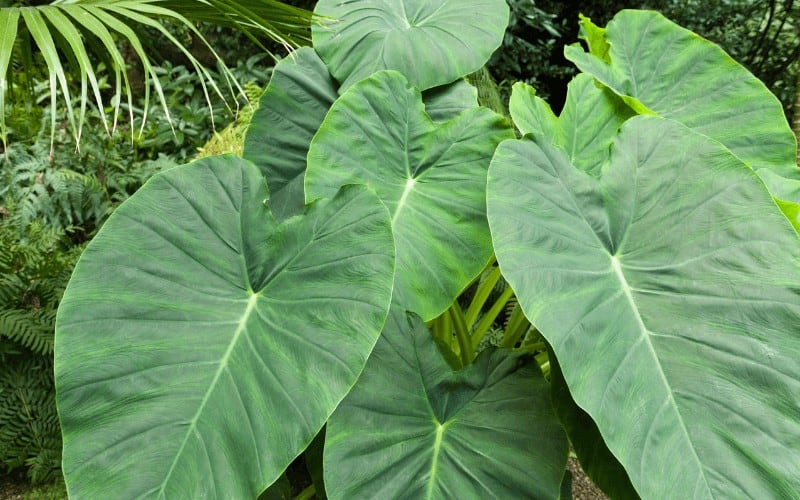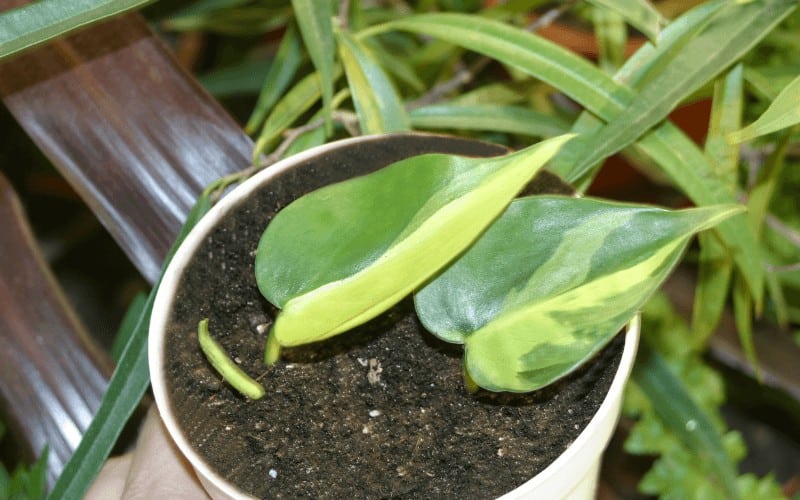The major difference between Philodendron cordatum vs hederaceum is in their soil, fertilizing, watering, light, and temperature requirements. We will talk more about this shortly.
It's worth noting that both the Philodendron cordatum and hederaceum are rare houseplants with striking similarities.
The hederaceum is also called the Philodendron hederaceum, and both plants belong to the Araceae family of the genus Philodendron. This is why people often mistake the Philodendron cordatum for Philodendron hederaceum.
On most websites, you will find contradictory care information on both plants as they are often mistaken for one another. This is exactly where this post becomes extremely important to young gardeners.
Below, we will be looking at how these two houseplants differs from each other. Let's get started!
Table of Contents
Philodendron Cordatum Overview

The Philodendron cordatum is an incredibly beautiful trailing houseplant with a heart-shaped emerald green leaves.
The plant is native to Central America and the Caribbean, and in its natural habitat, it would be found climbing up trees in the forest canopy. Cordatum thrives in bright but indirect light and also adapts to low and medium light spaces.
Philodendron Hederaceum Overview
Philodendron hederaceum originated from the Caribbean and Central America. The plant is usually found in swamps and on river banks, roadsides, and rock outcrops.
Hederaceum is a viny plant, and it's often found clambering over other plants or climbing the trunks of trees with the aid of aerial roots. The plant has heart-shaped glossy leaves with long leaf stalk.
The leaves have acutely pointed tips and look slightly brownish and almost transparent when they are new.
Hederaceum is commonly called Parlor Ivy, probably because of its trailing or climbing vine.
Philodendron Cordatum Vs Hederaceum

Below are some noticeable differences between Philodendron Cordatum and Hederaceum:
1. Plant Description
The Philodendron cordatum is a lovely trailing houseplant with heart-shaped emerald green leaves.
The plant is native to Central America and the Caribbean, and in its natural habitat, it would be found climbing up trees in the forest canopy. Cordatum thrives in bright but indirect light and also adapts to low and medium light spaces.
Similarly, the Hederaceum is native to Central America and the Caribbean, and just like the Philodendron Cordatum, it is usually found in swamps and on river banks, roadsides, and rock outcrops.
Both plants have heart-shaped green leaves, but on closer inspection, one will notice that Philodendron Cordatum has an emerald color while the Hederaceum is a bit glossy and lighter. Also.
The leaves of Hederaceum look slightly brownish and almost transparent when they are new; this is not common with Philodendron cordatum.
2. Soil Requirement for philodendron cordatum and hederaceum
Both plants also have almost the same soil requirements; both the Philodendron cordatum and Hederaceum will thrive best in a well-draining, light, and chunky soil. Both plants can grow in a pot, provide the container has drainage holes.
However, the potting mix of Philodendron Cordatum must contain peat, sphagnum, perlite, and wood bark, while the potting mix of Hederaceum has leaf mold or coarse peat moss.
3. Fertilizing for philodendron cordatum and hederaceum
The Philodendron cordatum should be fertilized with a dry organic fertilizer every 2-3 weeks in Spring and Summer.
In comparison, the Hederaceum should be applied to liquid fertilizer at least once every two weeks while the plant is actively growing.
4. Light
Philodendron cordatum thrives best in bright indirect sunlight and thus will not fare well in very low light. The plant will grow vigorously and happily in bright and indirect light.
However, it will wither away when exposed to direct sunlight, especially in the middle of the day. When it comes to light conditions, Hederaceum is quite tolerable when compare to Philodendron cordatum.
Hederaceum prefers medium light but will tolerate low light. Even though the plant will tolerate low light for quite a long time, it will thrive best on bright indirect light.
5. Watering philodendron cordatum vs hederaceum
Philodendrons cordatum is akin to water, so make sure you water the plant frequently and generously. When watering, ensure you are evenly moistening the soil to the bottom of the pot.
To ensure that the plant gets adequate water, water the plant until the water comes out of the drainage holes. It is advisable to water the Philodendron cordatum with distilled, rain, or aquarium water.
While Philodendron cordatum prefers to be watered generously, the Hederaceum should be watered moderately until the top of the soil is moist. Slow down on watering in the winter.
6. Temperature
The Philodendron cordatum will thrive best in temperatures between 65°- and 80°-degrees Fahrenheit (18° – 27° C).
Hederaceum will grow well in normal to warm indoor temperatures 24-27ºC (75-80ºF)
Frequently Asked Questions
Are Philodendron and Pothos the Same?
No, they are not. Both Philodendron and Pothos belong to the same Araceae family but different genera.
How Do You Care for A Philodendron Hederaceum?
Philodendron Hederaceum is relatively easy to care for. Make sure to water moderately in well-draining soil and keep the soil slightly moist. Provide bright, indirect sunlight and fertilize every two weeks.
How Do I Make My Philodendron Fuller?
To make your Philodendron fuller, use pruning shears or pinch the tips of vines.
How Can I Make My Philodendron Grow Faster?
Even though Philodendron can survive with very little light, the plant will thrive best in bright indirect sunlight.
Conclusion
It is common to mistake the Philodendron cordatum and hederaceum plant. The similarities between the plant thus necessitated the need for this post Philodendron cordatum vs hederaceum.
While the hederaceum is quite similar to Philodendron cordatum in terms of outlook and care, it may seem that the hederaceum is more tolerable in terms of maintenance.
Read Also:
- Carrot Flowers Vs Queen Anne’s Lace
- Is Philodendron Poisonous To Cats?
- Plants That Has Red Stems
- Plants That Has Waxy Leaves
- Brazil Pothos Vs Philodendron




